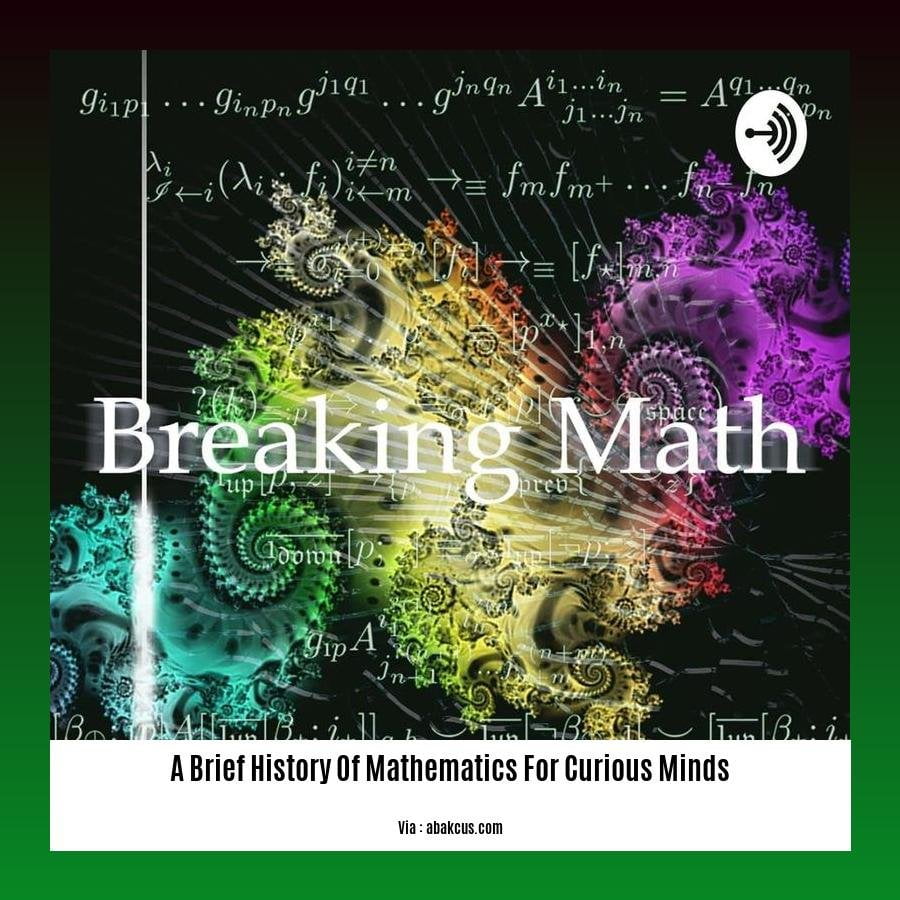Embark on a captivating journey through time with [- A Brief History of Mathematics for Curious Minds: A Journey Through Time and Ideas]. As we delve into the annals of mathematical history, we will uncover the brilliant minds, groundbreaking ideas, and pivotal moments that have shaped this fascinating subject.
Key Takeaways:
- Mathematics has a rich history dating back thousands of years.
- The 18th century significantly shaped mathematics through rationalism and the rejection of traditional ideas.
- The article provides an overview of the historical development of the subject.
A Brief History of Mathematics for Curious Minds

Mathematics, as we know it today, has a long and winding history, with origins that can be traced back at least 25,000 years to the Lebombo bone. This bone, found in southern Africa, contains a series of etched marks that are believed by some to be the earliest known example of a human-made mathematical calculation.
Over the centuries, mathematics has been used to solve problems in almost every area of human life, from engineering to economics to astronomy. It has also been used to create beautiful works of art and music.
In the 17th century, mathematics began to take on a more rigorous and theoretical form, with the development of calculus by Sir Isaac Newton and Gottfried Wilhelm Leibniz. This led to a wave of new discoveries in mathematics, including the development of differential equations and the theory of limits.
In the 19th century, mathematics began to be used to study the foundations of other sciences, such as physics and chemistry. This led to the development of new mathematical theories, such as set theory and group theory.
In the 20th century, the development of the computer led to a new era of mathematical discovery. Computers can be used to perform complex calculations that would have been impossible by hand. This has led to the development of new mathematical theories, such as chaos theory and fractals.
Today, mathematics is used in almost every aspect of our lives. It is used to design bridges, predict the weather, and even create new medicines. Mathematics is truly a universal language that can be used to understand the world around us.
Timeline of Major Mathematical Discoveries:
- 25,000 BC – Lebombo bone, the earliest known example of human-made mathematical calculation
- 3000 BC – Babylonian clay tablets containing mathematical problems and solutions
- 500 BC – The Pythagorean Theorem is discovered
- 300 BC – Euclid writes his “Elements”, a comprehensive treatise on geometry
- 100 AD – The Indian mathematician Aryabhata develops the decimal system and the concept of zero
- 1200 AD – The Persian mathematician Al-Khwarizmi develops algebra
- 1600 AD – René Descartes invents analytic geometry
- 1700 AD – Sir Isaac Newton and Gottfried Wilhelm Leibniz develop calculus
- 1800 AD – Pierre-Simon Laplace develops the Laplace transform
- 1900 AD – Georg Cantor develops set theory
- 2000 AD – The development of the computer leads to a new era of mathematical discovery, with the development of new mathematical theories, such as chaos theory and fractals.
Learn about the development of mathematical ideas by tracing through the short history of math. Get to know notable Short History Of Mathematics and their contributions. Explore the Short History Of Mathematicians and their impact on the field. Dive into the A Brief History Of Mathematical Thought to discover the evolution of mathematical concepts. Read Short Biography Of Mathematicians to learn about their personal lives and struggles. Finally, get a concise overview in our Short Note On History Of Mathematics.
Mathematics in the Middle Ages

Let’s embark on a journey through the fascinating world of Mathematics in the Middle Ages, a period that witnessed significant advancements and laid the groundwork for future mathematical discoveries.
The Middle Ages, spanning from the 5th to the 15th century, marked a crucial era in mathematical development. During this time, scholars across Europe, the Middle East, and Asia made remarkable contributions to the field, expanding existing knowledge and pioneering new frontiers.
Key Takeaways:
- During the Middle Ages, scholars made significant contributions to algebra, geometry, and trigonometry.
- The Arabic numeral system, widely used today, was introduced to Europe by Arab mathematicians.
- Universities and monasteries played a vital role in the preservation and advancement of mathematical knowledge.
- Mathematical concepts found practical applications in fields like architecture and navigation.
The Rise of Algebra
One of the most significant contributions of medieval mathematics was the development of algebra as a distinct field. Arab mathematicians, such as Al-Khwarizmi, laid the foundations of algebra, introducing concepts like polynomials, equations, and the use of variables. This paved the way for the systematic study of mathematical operations and solutions.
Geometric Discoveries
Medieval scholars also made significant advancements in geometry. They explored the properties of shapes, angles, and surfaces, expanding upon the work of ancient Greek mathematicians. Among these contributions were the development of new geometric theorems, the exploration of the Pythagorean theorem, and the application of geometry to practical problems.
The Practical Side of Mathematics
During the Middle Ages, mathematics was not only a subject of theoretical study but also a practical tool. Architects used geometric principles in the design and construction of buildings, while navigators employed trigonometry for calculating distances and directions. This interplay between mathematics and real-world applications laid the foundation for future scientific and technological advancements.
Legacy and Impact
The mathematical knowledge accumulated during the Middle Ages had a lasting impact on the development of mathematics as a discipline. The Arabic numeral system, for instance, became the standard system of notation, revolutionizing the way calculations were performed. Moreover, the work of medieval mathematicians laid the groundwork for the scientific revolution of the Renaissance and the development of modern mathematics.
Sources:
A History of Mathematics in the Middle Ages
Mathematics in the Middle Ages
The Renaissance and the Scientific Revolution
The era of The Renaissance and the Scientific Revolution marked a pivotal point in the development of mathematics. The rebirth of interest in classical learning spurred a rediscovery of mathematical texts, leading to a revival of Euclidean geometry and the development of new ideas.
During this time, artists and scientists like Leonardo da Vinci and Galileo Galilei recognized the interconnectedness of mathematics, art, and nature. Their investigations and experiments laid the foundation for the development of differential and integral calculus, ushering in a new era of mathematical innovation.
Key figures of the period, such as René Descartes, established analytical geometry, linking algebra and geometry and opening up new avenues of mathematical exploration. The rise of universities and scientific societies fostered a spirit of collaboration and intellectual exchange, contributing to the accelerated pace of mathematical advancement during this transformative era.
Key Takeaways:
- The Renaissance and the Scientific Revolution marked a revival of interest in mathematics and its applications.
- Rediscovery of classical texts and new ideas led to advancements in Euclidean geometry and the development of calculus.
- Interconnections between mathematics, art, and nature were recognized, leading to new perspectives and methodologies.
- Analytical geometry and scientific societies contributed to the exponential growth of mathematical knowledge.
Citations:
– The Renaissance and the Scientific Revolution
– Mathematics in the Scientific Revolution
Modern and Contemporary Mathematics
Over the centuries, mathematics has continuously evolved to address new challenges and discoveries. The 20th and 21st centuries have witnessed significant advancements in mathematical thought, leading to the development of new branches and concepts that have profoundly impacted various fields.
Key Developments in Modern and Contemporary Mathematics
- Set Theory: This theory, formulated by Georg Cantor, provides a foundation for understanding the structure and properties of infinite sets. It has revolutionized mathematics by allowing for the rigorous treatment of concepts such as infinity and transfinite numbers.
- Abstract Algebra: The study of algebraic structures, such as groups, rings, and fields, has led to a deeper understanding of symmetries and relationships in mathematics. Abstract algebra finds applications in coding theory, cryptography, and theoretical physics.
- Topology: The study of geometric properties that are invariant under continuous transformations, has provided insights into the structure of spaces and manifolds. Topology is used in areas such as knot theory, differential geometry, and algebraic topology.
- Category Theory: Developed by Alexander Grothendieck, category theory provides a unifying framework for representing and comparing mathematical structures. It has found applications in areas such as algebraic geometry, computer science, and mathematical physics.
- Number Theory: Advancements in number theory have yielded important insights into the distribution of prime numbers, the properties of Diophantine equations, and the connections between mathematics and computer science.
Impact on Science and Technology
Modern and Contemporary Mathematics has had a transformative impact on science and technology:
- Cryptography: Advances in number theory and abstract algebra have led to the development of secure encryption algorithms, ensuring the privacy and security of digital communications.
- Computer Science: Category theory and set theory provide foundations for computer science, including programming languages, databases, and artificial intelligence.
- Physics: Topology and abstract algebra have played crucial roles in the development of quantum mechanics and string theory.
Key Takeaways:
- The 20th and 21st centuries have witnessed significant advancements in mathematics, leading to the development of new branches and concepts.
- Set theory, abstract algebra, topology, category theory, and number theory are among the key developments in Modern and Contemporary Mathematics.
- Modern and Contemporary Mathematics has had a profound impact on science and technology, particularly in areas such as cryptography, computer science, and physics.
Relevant URL Sources:
- The Evolution of Modern Mathematics by Thinking Machines
- Modern and Contemporary Mathematics by the Mathematical Association of America
FAQ
Q1: What is the significance of the Lebombo bone in the history of mathematics?
A1: The Lebombo bone, estimated to be 43,000 years old, provides evidence of early mathematical thinking, suggesting that mathematical practices may have been present in prehistoric times.
Q2: How did the 18th century influence the development of mathematics?
A2: The 18th century witnessed a shift towards rationalism and skepticism, leading to a rejection of traditional views and a focus on empirical evidence, which impacted mathematical thinking and spurred advancements in the field.
Q3: What are some key mathematical concepts that emerged during the Renaissance and Scientific Revolution?
A3: During the Renaissance and Scientific Revolution, significant progress was made in mathematical concepts such as calculus, analytic geometry, and the development of new algebraic techniques, contributing to the advancement of mathematics and its applications in science and engineering.
Q4: How has mathematics influenced the progress of other disciplines?
A4: Mathematics has been a driving force in the development of other disciplines, providing a fundamental framework for understanding the world. It plays a crucial role in science, engineering, technology, economics, and many other fields.
Q5: What are some of the notable figures in the history of mathematics?
A5: Throughout history, there have been numerous influential figures in mathematics, including Archimedes, Euclid, Pythagoras, Isaac Newton, René Descartes, and many more. Their contributions and discoveries have shaped the field and laid the foundation for future advancements.
- China II Review: Delicious Food & Speedy Service - April 17, 2025
- Understand Virginia’s Flag: History & Debate - April 17, 2025
- Explore Long Island’s Map: Unique Regions & Insights - April 17, 2025
















